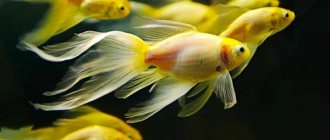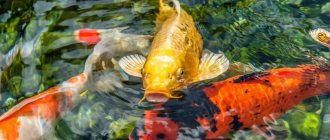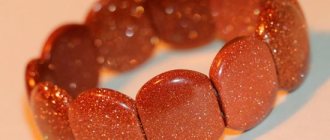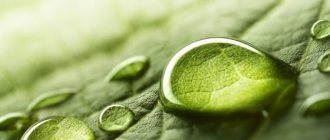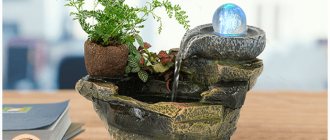5
(6)
Often, fish whose ancestors found dinosaurs on the planet become aquarium pets. One of these representatives of the ancient world is the Arowana. Residents of the East revere this fish as a sacred symbol of good luck and success in all matters. Therefore, it is not surprising that the cost of some types can reach hundreds of thousands of dollars.
Residents of the East revere Arowana as a sacred symbol of good luck and success in all matters.
Description
Aravana is a predatory fish. In nature, it lives in large rivers and basins of America, Africa and Southern China. The origin of freshwater fish begins in South America. In addition to being kept in an aquarium, arowana is used as food. Asian arowanas differ from American arowanas by having a short body.
Appearance
The fish reaches a length of 80 cm, in rare cases 120 cm. The body of the fish is long, ribbon-like, covered with large scales, which makes it look like a dragon. The fins are long and narrow, almost adjacent to the tail. The large mouth opens upward and allows the arowana to take food from the surface. Sensitive antennae are located on the lower jaw.
Behavior
The fish can jump to a height of 3 m from the surface and swims quickly. A skilled hunter, capable of obtaining food even on land. In nature, arowanas build a clear hierarchy when the dominant individual occupies a territory and does not allow weaker relatives to approach it. In the same aquarium, two individuals will inevitably have violent clashes. Despite their bloodthirstiness, dragon fish are shy. A sharp bright light or a sudden sound will cause the arowana to rush around the aquarium in panic. Smart fish that recognizes its owner.
Lifespan
Arowana lives 7–10 years with good care.
Habitat in nature
The silver arowana (Osteoglossum bicirrhosum) was first described by Cuvier in 1829. Its scientific name comes from the Greek words “Osteoglossum” meaning bony tongue and “bicirrhosum” meaning a pair of antennae. It got its common name for its body color - silver.
Lives in South America. As a rule, in large rivers and their tributaries - the Amazon, Rupununi, Oyapok. However, they do not like to swim upstream, preferring very quiet creeks and oxbow lakes.
In recent years they have also settled in California and Nevada. This became possible due to careless aquarists who released predatory fish into local water bodies.
In nature, fish eat whatever they can swallow. Its diet mainly consists of fish, but it also eats large insects. Plant foods make up a small part of her diet.
As already mentioned, if possible, fish jump out of the water and grab birds in flight or sitting on branches. In addition, monkeys, turtles, and rodents were found in the stomachs of caught fish.
Arowana is a very important part in the life of local residents. It is in great demand among them and brings fishermen a good income.
The meat has very low fat content and is delicious. It is also often sold to local aquarium fish dealers.
In addition, it is considered one of the most expensive fish. A rare platinum arowana was offered $80,000, but the owner refused to sell it, saying it was priceless.
Kinds
There are approximately 200 species of arowana, but about 10 are often kept in aquariums. The silver arowana is popular and is sold at a more affordable price.
Asian red
Famous and expensive fish from Southeast Asia. Body color is bright red. Endangered species. The owner must have a certificate of ownership.
Golden
Another endangered species. Young fish look less impressive than adults. The fish has a rich yellow-gold color and five horizontal rows of scales.
Black
Young black arowanas have dark fins and white and yellow stripes on their scales. As fish age, their scales darken.
African
African dragons differ from members of the family in structure. They live in the upper Nile, another rare species. Female African Arowanas look less bright.
Platinum
A unique fish with a perfect light color without inclusions of other colors. It grows up to 40 cm. It has another feature - it squints in one eye due to feeding from the surface. One platinum Arowana was offered for sale in Singapore, but the owner changed his mind and refused to sell.
Australian
Also known as pearl giardini. Smaller than other arowanas. Large scales with a pinkish edging, there are seven rows of scales. There are small light spots on the tail and fins.
South American silver
This species is cheaper than the Asian Arowana. The silver arowana lives in the Amazon basin. The scales of the fish shimmer in the light. The tail is wedge-shaped, the fins practically merge with it.
Myanmar
The species is especially popular in Asian countries. Also known as painted arowana. There is an intricate pattern on the light brown scales. It was discovered on the southern outskirts of Myanmar. It grows on average up to 60 cm in length.
Purchase and cost
It is problematic to freely purchase even young arowana fish, only to order. The cost of fry depends on the species , place of origin, growth and color quality and ranges from $20 to $500.
In large nurseries, a microchip is implanted into each individual, the parameters of which are documented when the fish is purchased. With its help, you can subsequently determine the origin, age and variety of fish. The cost of an adult fish raised in such a farm is high, and not everyone can purchase an exotic dragon fish.
The highest price of $80,000 was offered to a businessman from Singapore for a very rare platinum-painted arowana. But the owner flatly refused to sell his pet.
Content
Such rare and exotic fish live in professional aquariums. The equipment, the aquarium and the fish itself are very expensive.
Aquarium
You will need a tank with a volume of 800–1000 liters made of durable material, such as plexiglass. A heavy lid is required on top, as the fish jump out of the water. For decorations, use large driftwood.
Water parameters
| Temperature | 20–30 degrees |
| pH value | 6–7,5 |
| Rigidity | 8–12 dGH |
| Water movement | moderate or weak |
Change the water once a week by 25%. Do not allow sudden changes in parameters. Periodically test the water for hazardous chemicals and add water conditioner if necessary.
Plants
Plants in an arowana aquarium are not necessary. If you want to plant plants, choose flora with a strong root system:
- Vallisneria;
- Java fern;
- Anubias.
It is better to prepare small pots for plants; with such planting they will be less vulnerable. Use artificial plants as an alternative to living greenery.
Priming
Choose soil with a large diameter without sharp corners. For the rest, be guided by your own preferences. The bottom, strewn with leaves, will recreate the natural habitat in the aquarium. Siphon the soil thoroughly once a week.
Equipment
A set of equipment for the maintenance and high-quality care of the arowana:
- External filter. Arowanas quickly pollute water. Choose a powerful device; it should make at least three revolutions of water per hour. Multiple filters may be required. Better filtration is carried out by mixed type filters - mechanical and biological.
- Compressor. The liquid must be saturated with oxygen. A powerful compressor together with plants will ensure the arowanas breathe. A lack of oxygen is indicated by rapid breathing of the fish and its predominance in the upper layers of water
- Heater. Placed as needed if the room is not warm enough.
- Cooler. Necessary in the summer if the water temperature rises above 30 degrees. The replacement is canisters and ice packs, which gradually cool the water.
Lighting
Arowanas live in dim light. Equip the lighting system so that the light turns on gradually and does not stress the fish. First, smoothly turn on the light in the room, then in the aquarium. Metal halide and LED lamps are suitable for lighting a large aquarium. Lamps should not overheat the water. Think about heat dissipation in advance. You can install the light on an aluminum plate or place a cooler. If there are live plants in the pond, make sure they have enough light.
View this post on Instagram
#superred #arowana #dragonfish #southeastasia #asia #arowanafish #australia #ornamentalfish #superredarowana #dubai #england #guangzhou #beijing #shanghai #indonesia #japan #southkorea #korea #taiwan #russia #hongkong #australia #mengjier #india #ornamentalfish #singapore #china #monsterfishkeepers #ultraredarowana #europe #asianarowana #mpu
A post shared by PTMunjulPrimaUtama (@ptmunjulprimautama) on Sep 25, 2021 at 8:52pm PDT
Where does the Aravana live?
Photo: Arawana fish
South America is considered the homeland of the dragon fish. In ancient times, fish was ubiquitous in all regions with a tropical climate. Today it lives in almost all freshwater bodies.
Geographical regions of the Aravana habitat:
- some fresh water bodies of North America;
- Amazon river;
- Oyapok;
- Essequibo;
- southern regions of China;
- Burma;
- Vietnam;
- Guyana Basin;
- Southeast Asia.
The fish can thrive in waters with low oxygen levels. In many countries around the world, fish are raised under artificial conditions in many rivers. In regions of their natural habitat, fish choose places where the current is not too strong, quiet and secluded regions.
To keep fish in aquarium conditions, it is recommended to choose an aquarium with a capacity of at least 750 liters, preferably even 1000 liters. It should be covered with an opaque lid on top. It is advisable to equip it with a type of lighting that will not turn on abruptly, but gradually, gradually flare up. It is best if the aquarium is made of plexiglass, since the fish are quite strong and large.
The aquarium must have a filter for water purification that can siphon the bottom and change at least a quarter of all water weekly. Plants are not necessary for these representatives of marine flora and fauna. They feel quite comfortable without them. Hardness is 8-12, acidity 6.5-7. Fish categorically does not accept an alkaline environment.
Feeding
The arowana's diet consists mainly of animal feed:
- frogs;
- tadpoles;
- coreters;
- grasshoppers;
- mice;
- beef and chicken heart;
- crickets;
- bloodworm;
- small fish;
- shrimp;
- mussels;
- Zhukov.
Some animals, such as fish and crickets, can be raised at home. Fish and insects should not show signs of illness. Treat feed in baths of methylene blue solution, others in boiling water. Remove the fat from the meat and cut into 1 cm pieces. Do not overfeed the predators; give them a fasting day 1-2 times a week. In its natural environment, the arowana occasionally consumes plant foods such as aquatic plants and fruits that have fallen into the water.
Fish nutrition
Aravana feeds only on animal food; the following are suitable for these purposes:
- crickets and grasshoppers: they contain protein that improves coloring;
- frogs are a delicacy for arawana, but you should not feed them too often, otherwise the fish will refuse other food;
- live fish allow her to hunt;
- mice: playing with them is more like a show, the fish enjoy swimming with them;
- insects: contain protein that aids digestion.
In order for the scales to acquire a rich color, the Aravana should be fed with bloodworms, shrimp or cod fish.
Animal food is a healthy food for this predator, but since it is difficult to have it constantly available, the “dragon” can be fed with freshly frozen foods: shrimp, beef heart and sea fish - after defrosting.
Compatibility
Optimally single content. Goldfish, viviparous fish, carp fish and medium-sized cichlids are regarded exclusively as food. It is acceptable to keep an arowana with large neighbors:
- paku;
- giant gouramis;
- astronotuses;
- Indian knife;
- slobbering catfish;
- plecostomus;
- brocade pterygoplicht.
Do not allow the predator to go hungry, equip the aquarium with numerous hiding places and maintain the most comfortable conditions, then the arowana will get along with its neighbors.
View this post on Instagram
My aquarium Double Tap & Comment Below ?FOLLOW FOR MORE @polysaur_jurassicfish #bichir #endlicheri #senegalus #fish #bichirbichir #delhezi #primitivefish #freshwater #congicus #fishtank #aquarismo #aquario #freshwaterfish #aquariumhobby #exoticpet #africanfish #bichirs #aquarium # fish #ポリプテルス #fish #arowana #jardini #garfish #spottedgar #monsterfishkeeper #polypterus #アロワナ #poytara #mbreda
A post shared by Primitive fish (@polysaur_jurassicfish) on Sep 28, 2021 at 5:26pm PDT
Reproduction
Arowana does not breed in an aquarium. It is possible to breed fish in ponds and pools.
Sex differences
Sexual dimorphism is weakly expressed. The male looks somewhat more graceful and has a long anal fin. In some species, the color of males is more intense.
Spawning
Fish spawn in warm water. The male carries the eggs, 1.5 cm in diameter, in his mouth for 4–5 weeks and is in no hurry to release the fry even after hatching. The young begin to swim independently after 3–4 days. First, the fry feed on the contents of the yolk sac, then on daphnia, worms or insect larvae.
Breeding
Aravana (brak fish) is a talisman that many people strive to breed in their aquarium. In order for a fish to give birth, it is necessary to provide it with comfortable conditions that correspond to its natural habitat.
The aquarium must be at least two meters. If you breed it in a pond, then the water should be warm. The female lays the eggs, and the male guards the fry. It is he who holds the caviar in the mouth for about two months. After the fry become independent, they can be transplanted to another place. By providing proper care, you can achieve a long life of the Arawana (up to twelve years).
Diseases
The water dweller has a strong immune system. The fish does not have any species-specific diseases and is susceptible to the same diseases as other aquarium fish. The disease starts in the aquarium due to infrequent and improper maintenance. If a white coating or dots appear on the fish’s body, the pet has a fungal infection. Treat the predator with malachite green or medications containing phenoxyethanol. Poisoning and temperature shock require gradual improvement of conditions and adjustment of temperature to a comfortable level.

